Isaac Jacobs (1757 – August 1835), was a designer and manufacturer of Bristol blue glass, and is believed to be its inventor.
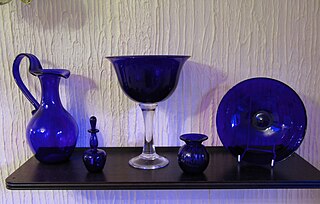
Bristol blue glass has been made in Bristol, England, since the 18th century, with a break between the 1920s and 1980s.
Isaac Jacobs (1757 – August 1835), was a designer and manufacturer of Bristol blue glass, and is believed to be its inventor.

Bristol blue glass has been made in Bristol, England, since the 18th century, with a break between the 1920s and 1980s.
Isaac was one of three children of Lazarus Jacobs, a Jewish immigrant from Frankfort am Main, and Mary Hiscocks, from Templecombe, Somerset. Lazarus moved to Bristol in around 1760, where he began his career as an itinerant glass-cutter. He sold his wares, along with secondhand goods, at Temple Fair in Bristol.

Jews or Jewish people are an ethnoreligious group and a nation, originating from the Israelites and Hebrews of historical Israel and Judah. Jewish ethnicity, nationhood, and religion are strongly interrelated, as Judaism is the traditional faith of the Jewish people, while its observance varies from strict observance to complete nonobservance.
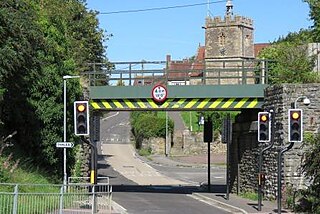
Templecombe is a village in Somerset, England, situated on the A357 road five miles south of Wincanton, twelve miles east of Yeovil, and 30 miles west of Salisbury. The village has a population of 1,560. Along with the hamlet of Combe Throop it forms the parish of Abbas and Templecombe.

Somerset is a county in South West England which borders Gloucestershire and Bristol to the north, Wiltshire to the east, Dorset to the south-east and Devon to the south-west. It is bounded to the north and west by the Severn Estuary and the Bristol Channel, its coastline facing southeastern Wales. Its traditional border with Gloucestershire is the River Avon. Somerset's county town is Taunton.
In 1774 he set up a glass manufacturing business at 108 Temple Street. Isaac joined his father's business as a partner at age seventeen. [1] Using cobalt oxide imported by William Cookworthy from Saxony, Isaac designed and branded Bristol blue glass as it is known today.
Cobalt oxide may refer to:
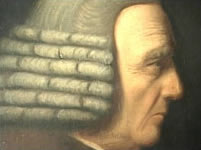
William Cookworthy was an English Quaker minister, a successful pharmacist and an innovator in several fields of technology.

Saxony, officially the Free State of Saxony, is a landlocked federal state of Germany, bordering the federal states of Brandenburg, Saxony Anhalt, Thuringia, and Bavaria, as well as the countries of Poland and the Czech Republic. Its capital is Dresden, and its largest city is Leipzig.
The Jacobs family were well-placed to develop Bristol blue glass: German glass engraving was highly prized, and continental Jews worked traditionally with coloured glass. Many of Isaac's glasses, signed by him, can be found in the Victoria and Albert Museum and elsewhere. [2]

Glass engraving is a form of decorative glasswork that involves engraving a glass surface or object. It is distinct from glass art in the narrow sense, which refers to moulding and blowing glass, and from glass etching which uses acidic, caustic, or abrasive substances to achieve artistic effects. Some artists may combine two or more techniques. There are several different types of glass engraving.

The Victoria and Albert Museum in London is the world's largest museum of applied and decorative arts and design, as well as sculpture, housing a permanent collection of over 2.27 million objects. It was founded in 1852 and named after Queen Victoria and Prince Albert.
In 1786, Lazarus helped fund a new synagogue, where he was honoured by the Jewish community. At the time, the Jewish community was gradually being accepted into Gentile Bristol society. [3] By the early nineteenth century, Jews were moving from 'the Jew quarter' at Temple, to St James's and Brunswick Square. When Lazarus died in 1796, Isaac took over the business, and was able to move his family to 16 Somerset Square Redcliffe, near the glass factory. As the success of Bristol Blue Glass increased, Isaac became a leading member of the Jewish community, while also adopting aspects of Gentility, reflecting the increasing balance of both worlds. Between 1809 and 1814, Isaac was made a freeman of the city of Bristol, moved to a large house he had commissioned in Weston-super-Mare, was granted a coat of arms, and became a member of the Bristol Commercial Rooms. He was making between £15,000 and £20,000 a year. [4]

A synagogue, is a Jewish or Samaritan house of worship.
When the demand for glass dropped, Isaac borrowed money to try and prop up his business. When a loan he made to a friend of £2,000 was not repaid, Isaac could not repay his own debts. In 1820, he was declared bankrupt, and accused of fraud. The charges were dropped, but too late: he sank to being a peddler, returning to the trade of his father. He died in 1835, and was buried in the cemetery he had bought for the Jewish community at St Phillip's twenty years earlier. [4]

Bankruptcy is a legal process through which people or other entities who cannot repay debts to creditors may seek relief from some or all of their debts. In most jurisdictions, bankruptcy is imposed by a court order, often initiated by the debtor.

A peddler, in British English pedlar, also known as a canvasser, chapman, cheapjack, hawker, higler, huckster, monger, or solicitor, is a traveling vendor of goods. In England, the term was mostly used for travellers hawking goods in the countryside to small towns and villages; they might also be called tinkers or gypsies. In London more specific terms were used, such as costermonger.
A letter in the Bristol Record Office gives a glimpse into the factory. [5]
On 10 June 1808, Harriet Keyser, Isaac Jacob's daughter, wrote to David Samuels, manager at her father's glass factory. Harriet is planning a party, and asks David to send her a set of glassware. What was a party plan two hundred years ago is now an important historical document. The letter tells what glass Jacobs' company was manufacturing. The list includes blue and clear glass, as well as 'gilt-edged' glass. Harriet asks for a decanter, a jug, champagne glasses and 'finger cups', as well as glassware for lemonade and jelly. This might be the 'Dessert set' that Isaac's advertising campaign describes as 'burnished gold upon royal purple coloured glass', which they 'had the honour of sending to their Majesties'. [6] Isaac's purple glass is on display at the Victoria and Albert Museum. [7]
Another letter in the Bristol Record Office gives a glimpse into the Jacobs family. [8]
On 9 September 1833, Isaac wrote to his granddaughter, Augusta Keyser. He thanks her for her letter and wishes of good health, saying, 'I can fancy you are grown a fine woman.' He says he hopes to see her 'in good health, and sooner than you expect'. He would die in poverty two years later. Isaac was married to Mary MacCreath of Shrewsbury, a Christian woman. They had four children: Augusta Keyser, Matilda Alexander, Lionel Jacobs, and Joseph Jacobs. In 1817, Matilda married Abraham Alexander, who became Bristol's first Jewish town councillor. Abraham was elected in 1844, a year before Parliament lifted the restriction on Jews holding municipal office. Abraham's brother William was elected alderman in 1850. [3] The Alexander family went on to become the next leading Jewish family in Bristol.

Abraham, originally Abram, is the common patriarch of the three Abrahamic religions. In Judaism, he is the founding father of the covenant of the pieces, the special relationship between the Jewish people and God; in Christianity, he is the prototype of all believers, Jewish or Gentile; and in Islam he is seen as a link in the chain of prophets that begins with Adam and culminates in Muhammad.

Isaac is one of the three patriarchs of the Israelites, according to the biblical Book of Genesis. In the biblical narrative, he was the son of Abraham and Sarah, the father of Jacob, and grandfather of twelve tribes of Israel; his name means "he will laugh", reflecting when both Abraham and Sarah laughed in disbelief when told that they would have a child. He is the only patriarch whose name was not changed, and the only one who did not move out of Canaan. According to the narrative, he died when he was 180 years old, the longest-lived of the three.

The Cave of the Patriarchs or Tomb of the Patriarchs, known to Jews as the Cave of Machpelah and to Muslims as the Sanctuary of Abraham, is a series of caves located in the heart of the old city of Hebron in the southern West Bank. According to the Abrahamic religions, the cave and adjoining field were purchased by Abraham as a burial plot.

English Jewish Literature:
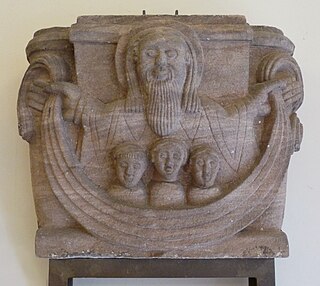
"Bosom of Abraham" refers to the place of comfort in the Biblical Sheol where the righteous dead await Judgment Day.
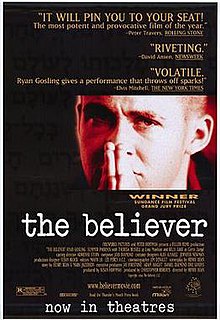
The Believer is a 2001 American drama film directed by Henry Bean and written by Bean and Mark Jacobson. It stars Ryan Gosling as Daniel Balint, a Jew who becomes a neo-Nazi. The film is loosely based on the true story of Dan Burros, a member of the American Nazi Party and the New York branch of the United Klans of America. He committed suicide after being revealed as Jewish by a New York Times reporter. It won the Grand Jury Prize at the 2001 Sundance Film Festival and the Golden St. George at the 23rd Moscow International Film Festival.
Bostanai, also spelled Bustenai, was the first exilarch under Arabian rule; he flourished about the middle of the 7th century. The name is Aramaized from the Persian bustan or bostan, meaning "Garden". Almost the only exilarch of whom anything more than the name is known, he is frequently made the subject of legends.
Jacob Joseph served as chief rabbi of New York City's Association of American Orthodox Hebrew Congregations, a federation of Eastern European Jewish synagogues. Born in Krozhe, a province of Kovno, he studied in the Nevyozer Kloiz under Rabbi Yisrael Salanter and in the Volozhin yeshiva under the Netziv. In Volozhin, he was known as "Rav Yaakov Charif" because of his sharp mind.
Many of the thirteen children of Daniel Itzig and Miriam Wulff, and their descendants and spouses, had significant impact on both Jewish and German social and cultural history. Notable ones are set out below.

Isaac Leeser was an American, Ashkenazi Jewish religious leader, teacher, scholar and publisher. He helped found the Jewish press of America, produced the first Jewish translation of the Bible into English, and helped organize various social and educational organizations. He is considered one of the most important nineteenth century American Jewish personalities. He was "fiercely opposed" to Reform Judaism and is regarded as one of the most important Orthodox rabbis of his era.
Judah ben Isaac Messer Leon (1166–1224) was a French tosafist born in Paris. According to Gross he was probably a descendant of Rashi, and a pupil of Isaac ben Samuel of Dampierre and his son Elhanan. He married a daughter of Abraham ben Joseph of Orleans, who has been identified by Jacobs with Abraham fil Rabbi Joce, chief Jew in London in 1186. In a list of that year associated with Abraham occurs the name of Leo Blund, whom Jacobs identifies with Judah ben Isaac.
Isaac ben Chayyim Cansino (Cancino) was a poet and prominent member of the Jewish community of Oran, Algeria. He was probably a brother of Jacob Cansino II. Cansino was a liturgical poet of high attainments, and cantor in the synagogue on the Day of Atonement, an office regarded as a post of honor. Cansino's greatest work is the first part of the so-called Machzor Oran, which contains many poems written by him. Among his occasional poems is one in praise of the collection of poems Aguddat Ezob by Abraham ben Jacob Cansino; a dirge on the death of Aaron Cansino in 1633; and one of sympathy to Samuel Cansino on the occasion of the loss of his fortune by the cheating of gamblers.
Temple Beth Elohim is a Reform synagogue located at 230 Screven Street in Georgetown, South Carolina.
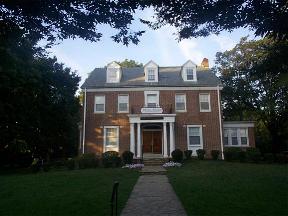
Few Jews arrived in Baltimore, Maryland, in its early years. As an immigrant port of entry and border town between North and South and as a manufacturing center in its own right, Baltimore has been well-positioned to reflect developments in American Jewish life. Yet, the Jewish community of Baltimore has maintained its own distinctive character as well.
Raphael Jacob Moses (1812–1893) was an American lawyer, plantation owner, Confederate officer and politician.
Georg Josef Riedel is an Austrian glassmaker and businessman. He is the 10th-generation owner of Riedel established in 1756 and best known for its production of grape variety-specific glassware designed to enhance types of wines based on specific properties of individual grape varieties. Georg Riedel joined the family business in 1973 serving as accountant, before rising to co-CEO of Riedel Crystal alongside his father, Professor Claus Josef Riedel, from 1987 until 1994. He served as Chief Executive Officer from 1994 until 2013. Georg Riedel succeeded his father, who first developed the concept of wine-enhancing glassware in 1958, and is best known for bringing variety-specific wine glasses to a global audience.
Lazarus Leonard Aaronson, often referred to as L. Aaronson, was a British poet and a lecturer in economics. As a young man, he belonged to a group of Jewish friends who are today known as the Whitechapel Boys, many of whom later achieved fame as writers and artists. Though less radical in his use of language, he has been compared to his more renowned Whitechapel friend, Isaac Rosenberg, in terms of diction and verbal energy. Aaronson's poetry is characterised more as 'post-Georgian' than modernistic, and reviewers have since been able to trace influences back to both the English poet John Keats, and Hebrew poets such as Shaul Tchernichovsky and Zalman Shneur.

Sir Abraham Elton, 2nd Baronet of Bristol and Clevedon Court, Somerset, was a British merchant and Whig politician, who sat in the House of Commons for Taunton between 1724 and 1727, and then for Bristol from 1727 until his death in 1742. He also served as the High Sheriff of Bristol from 1710 to 1711, and was Mayor of Bristol for the year 1719 to 1720.